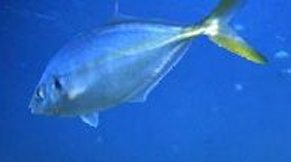 The
Trevally is a deep bodied sleek stream lined fish pelagic fish.
The
Trevally is a deep bodied sleek stream lined fish pelagic fish.
It can be found in dense schools generally in the northern waters of the North Island, often seen shoaling at the surface. Though in the summer months it may be seen or caught in the South island.
They generally swim over muddy and sandy bottoms and over rocky areas to depths of around 340' or 100 metres.
The Trevally has a deep body, and two separated dorsal fins, the first high and triangular and the second lower and longer, and row of small ridged plates near the base of the deeply forked tail.
It also has a small soft mouth.
This fish is a silverish greenish colour with metallic look and the dark spot above the gill plate. It's fins are yellowish.
Trevally are strong fast swimmers much the same as kahawai or kingfish.
The Trevally grows to a little over 2' or 60 cm long, and eat small planktonic shrimp, and small invertebrates gathered from the sand or muddy bottoms.
When trevally are between 15cm to 40cm they are more slender with a pointed snout and a uniform silver-grey body colour, sometimes with faint yellow tinges on the fins and a black spot on the gill cover.
When they are over 40cm in size they develop a deeper body and develop a pronounced hump on their foreheads. They become a dark green blue colour above, often with a yellow sheen, and have bright yellow tinged fins. These adult fishes form large schools, sometimes covering many hectares of area on the surface.
Trevally are a slow growing fish. At about one year old they are under 12cm, at around three years old they are about 30cm, and fish older that 10 years old are 40cm plus.
I have encountered these fish mainly between Goat Island out from Leigh, up to the Poor Knights group and around the North Cape down the west coast to the Bluff outlet on the Ninety Mile Beach.
It is beleived that these fish spawn in the summer though I do not know this for certain. Their eggs are pelsgic and hatch in just over a day after being fertilised. The larvae settle after about two months.
Juvenile fish are around 40mm in length and are found in the shallow inshore areas such as estuaries and harbours.